The global foam mixing machine market is valued at USD 860 million in 2025. It is slated to reach USD 1,310 million by 2035, recording an absolute increase of USD 450 million over the forecast period. This translates into a total growth of 52.3%, with the market forecast to expand at a compound annual growth rate (CAGR) of 4.3% between 2025 and 2035. The overall market size is expected to grow by nearly 1.52X during the same period, supported by increasing demand for polyurethane foam applications in automotive and construction sectors, growing adoption of automated mixing systems in manufacturing facilities, and rising emphasis on precision metering and energy-efficient production technologies across diverse industrial, construction, and consumer product applications.
Between 2025 and 2030, the foam mixing machine market is projected to expand from USD 860 million to USD 1,060 million, resulting in a value increase of USD 200 million, which represents 44.4% of the total forecast growth for the decade. This phase of development will be shaped by increasing automotive production volumes and lightweighting requirements, rising adoption of automated foam processing systems in appliance manufacturing, and growing demand for high-pressure mixing equipment in rigid foam insulation applications. Foam equipment manufacturers and industrial processors are expanding their machine capabilities to address the growing demand for precision mixing solutions that ensure product consistency and production efficiency.
From 2030 to 2035, the market is forecast to grow from USD 1,060 million to USD 1,310 million, adding another USD 250 million, which constitutes 55.6% of the overall ten-year expansion. This period is expected to be characterized by the expansion of electric vehicle interior component production, the development of advanced mixing technologies for specialty foam formulations, and the growth of construction panel manufacturing utilizing rigid foam insulation systems. The growing adoption of Industry 4.0 principles and smart manufacturing platforms will drive demand for foam mixing machines with enhanced automation capabilities and real-time process monitoring features.
Between 2020 and 2025, the foam mixing machine market experienced steady growth, driven by increasing automotive interior component production standards and growing recognition of automated mixing systems as essential equipment for enhancing foam quality and production efficiency in diverse industrial applications. The market developed as manufacturing engineers and process specialists recognized the potential for advanced mixing technology to improve material consistency, reduce waste generation, and support sustainability objectives while meeting stringent quality requirements. Technological advancement in metering accuracy and process control began emphasizing the critical importance of maintaining precise component ratios and mixing uniformity in challenging production environments.
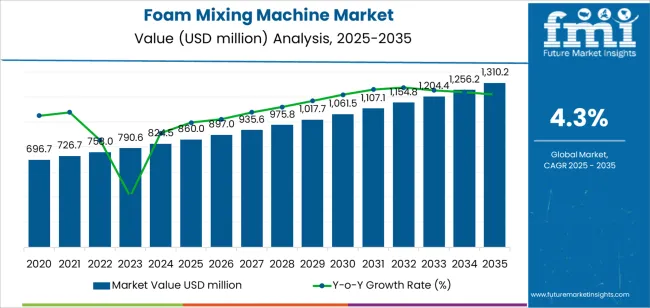
| Metric | Value |
|---|---|
| Estimated Value in (2025E) | USD 860 million |
| Forecast Value in (2035F) | USD 1,310 million |
| Forecast CAGR (2025 to 2035) | 4.3% |
Market expansion is being supported by the increasing global demand for polyurethane foam applications driven by automotive interior production growth and construction insulation requirements, alongside the corresponding need for advanced mixing equipment that can enhance processing accuracy, enable consistent foam properties, and maintain operational efficiency across various automotive, appliance, construction, and packaging applications. Modern foam processors and component manufacturers are increasingly focused on implementing mixing systems that can improve material utilization, enhance production throughput, and provide consistent performance in demanding manufacturing conditions.
The growing emphasis on automation and process optimization is driving demand for foam mixing machines that can support automated production lines, enable precise ratio control, and ensure comprehensive quality assurance. Industrial manufacturers' preference for mixing equipment that combines processing accuracy with operational reliability and energy efficiency is creating opportunities for innovative machine implementations. The rising influence of electric vehicle production and advanced building insulation standards is also contributing to increased adoption of mixing systems that can provide superior foam characteristics without compromising production speed or material economy.
The market is segmented by foam chemistry, metering/mix type, application, automation level, and region. By foam chemistry, the market is divided into PU-flexible, PU-rigid, silicone/epoxy, and phenolic & others. Based on metering/mix type, the market is categorized into high-pressure meter mix, low-pressure mix, static mixers, and vacuum-assisted. By application, the market includes automotive seating/trim, appliances/insulation, construction panels, and packaging/gasketing/other. Based on automation level, the market is divided into batch/manual assist, semi-automatic, and fully automatic. Regionally, the market is analyzed across major industrial economies and manufacturing centers.
The high-pressure meter mix segment is projected to maintain its leading position in the foam mixing machine market in 2025 with a 42% market share, reaffirming its role as the preferred mixing technology for high-volume polyurethane foam production and precision component manufacturing applications. Foam processors and automotive suppliers increasingly utilize high-pressure systems for their superior mixing efficiency, excellent material distribution characteristics, and proven effectiveness in achieving consistent foam properties while maintaining production speed and material economy. High-pressure meter mix technology's proven effectiveness and application versatility directly address the industry requirements for high-quality foam production and automated manufacturing solutions across diverse automotive platforms and industrial applications.
This metering segment forms the foundation of modern automated foam processing, as it represents the technology with the greatest contribution to production efficiency improvements and established performance record across multiple foam applications and manufacturing environments. Industrial sector investments in automated mixing technologies continue to strengthen adoption among foam processors and component manufacturers. With production requirements demanding improved consistency and reduced cycle times, high-pressure meter mix systems align with both quality objectives and operational requirements, making them the central component of comprehensive automated manufacturing strategies.
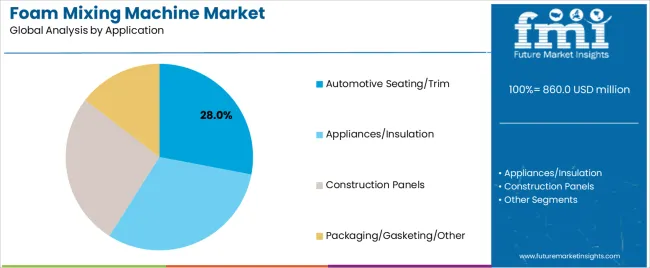
The automotive seating/trim application segment is projected to represent the largest share of foam mixing machine demand in 2025 with a 28% market share, underscoring its critical role as the primary driver for mixing equipment adoption across passenger car seating, commercial vehicle interiors, and premium automotive trim applications. Automotive suppliers prefer foam mixing systems for component production due to their exceptional processing capabilities, production efficiency benefits, and ability to achieve consistent foam properties while supporting quality requirements and cost competitiveness. Positioned as essential equipment for modern automotive manufacturing, foam mixing machines offer both production advantages and quality benefits.
The segment is supported by continuous innovation in automotive interior technology and the growing availability of advanced mixing systems that enable superior component performance with enhanced durability and reduced production costs. Additionally, automotive manufacturers are investing in comprehensive automation programs to support increasingly stringent quality standards and consumer demand for premium interior components. As automotive production accelerates and lightweight material adoption increases, the automotive seating/trim application will continue to dominate the market while supporting advanced mixing technology utilization and component quality optimization strategies.
The foam mixing machine market is advancing steadily due to increasing demand for automated foam processing solutions driven by automotive production growth and growing adoption of advanced mixing technologies that require specialized equipment providing enhanced precision characteristics and efficiency benefits across diverse automotive, appliance, construction, and packaging applications. The market faces challenges, including high capital investment requirements and installation costs, competition from manual mixing methods and alternative foam processing technologies, and technical constraints related to maintenance complexity and operator training requirements. Innovation in smart mixing systems and automated process control continues to influence product development and market expansion patterns.
The growing adoption of electric vehicles is driving demand for specialized interior foam solutions that address unique performance requirements including weight reduction for extended battery range, noise reduction for quieter cabin environments, and optimized comfort characteristics for premium interior experiences. Electric vehicle interiors require advanced foam mixing systems that deliver precise formulations across multiple component applications while maintaining production efficiency and cost-effectiveness. Automotive suppliers are increasingly recognizing the competitive advantages of automated mixing technology for electric vehicle component production and market differentiation, creating opportunities for innovative mixing systems specifically designed for next-generation mobility applications.
Modern foam mixing machine manufacturers are incorporating digital connectivity and automated process control technologies to enhance production monitoring, reduce material waste, and support comprehensive manufacturing efficiency objectives through real-time data analytics and predictive maintenance capabilities. Leading equipment producers are developing IoT-enabled mixing systems with automated ratio adjustment, implementing cloud-based process monitoring platforms, and advancing machine technologies that optimize energy consumption and production throughput. These technologies improve operational efficiency while enabling new capabilities, including remote diagnostics, automated formulation management, and data-driven process optimization. Advanced digitalization also allows manufacturers to support comprehensive quality assurance objectives and operational excellence beyond traditional mixing performance attributes.
The expansion of construction insulation requirements, advanced packaging solutions, and specialty industrial applications is driving demand for mixing equipment with enhanced capabilities for processing specialty foam formulations including fire-resistant materials, bio-based polyurethanes, and high-performance insulation foams. These advanced applications require specialized mixing systems with precise temperature control and exceptional formulation flexibility that exceed traditional automotive foam requirements, creating premium market segments with differentiated value propositions. Manufacturers are investing in advanced machine capabilities and application-specific development programs to serve emerging high-value applications while supporting innovation in construction, industrial, and specialty foam sectors.
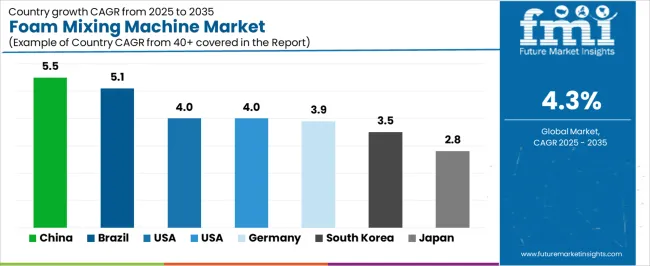
| Country | CAGR (2025-2035) |
|---|---|
| China | 5.5% |
| Brazil | 5.1% |
| USA | 4% |
| UK | 4% |
| Germany | 3.9% |
| South Korea | 3.5% |
| Japan | 2.8% |
The foam mixing machine market is experiencing solid growth globally, with China leading at a 5.5% CAGR through 2035, driven by expanding automotive production capacity, growing appliance manufacturing scale, and increasing adoption of automated mixing systems in construction panel production. Brazil follows at 5.1%, supported by automotive sector growth, expanding furniture manufacturing, and rising construction activity utilizing polyurethane insulation systems.
The United States and United Kingdom both demonstrate 4% growth, supported by automotive interior innovation, appliance manufacturing modernization, and construction insulation adoption. Germany records 3.9%, focusing on premium automotive applications, engineering precision, and process automation in foam component production. South Korea shows growth at 3.5%, emphasizing automotive supplier capabilities and appliance manufacturing efficiency. Japan exhibits 2.8% growth, emphasizing precision mixing technology for automotive and industrial applications.
The report covers an in-depth analysis of 40+ countries, top-performing countries are highlighted below.
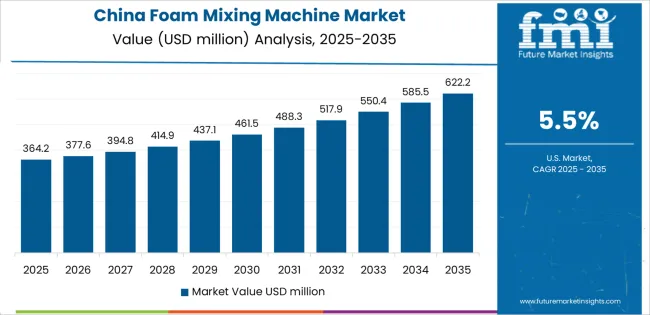
Revenue from foam mixing machines in China is projected to exhibit exceptional growth with a CAGR of 5.5% through 2035, driven by expanding automotive production capacity and rapidly growing appliance, construction panel, and industrial foam manufacturing sectors supported by government industrial modernization initiatives and infrastructure development programs. The country's massive manufacturing sector expansion and increasing investment in automated production technologies are creating substantial demand for foam mixing equipment solutions. Major automotive suppliers and chemical equipment companies are establishing comprehensive mixing system production capabilities to serve both domestic markets and export opportunities.
Revenue from foam mixing machines in Brazil is expanding at a CAGR of 5.1%, supported by the country's growing automotive industry, expanding furniture manufacturing sector, and increasing construction activity utilizing polyurethane foam insulation systems. The country's developing manufacturing infrastructure and industrial modernization programs are driving sophisticated foam mixing equipment capabilities throughout diverse production sectors. Leading automotive suppliers and equipment manufacturers are establishing production and distribution facilities to address growing domestic demand.
Revenue from foam mixing machines in the United States is expanding at a CAGR of 4%, supported by the country's focus on automotive interior innovation, established appliance manufacturing sector, and growing emphasis on construction insulation performance and energy efficiency. The nation's comprehensive automotive supply chain and industrial manufacturing capabilities are driving demand for sophisticated foam mixing solutions. Automotive suppliers and equipment manufacturers are investing in production technology upgrades to serve both domestic and export markets.
Revenue from foam mixing machines in Germany is expanding at a CAGR of 3.9%, driven by the country's premium automotive sector, engineering equipment innovation, and precision manufacturing capabilities supporting advanced foam processing technology development for high-performance applications. Germany's automotive excellence and machinery manufacturing leadership are driving sophisticated mixing equipment capabilities throughout industrial sectors. Leading equipment manufacturers and automotive suppliers are establishing comprehensive technology development programs for next-generation mixing systems.
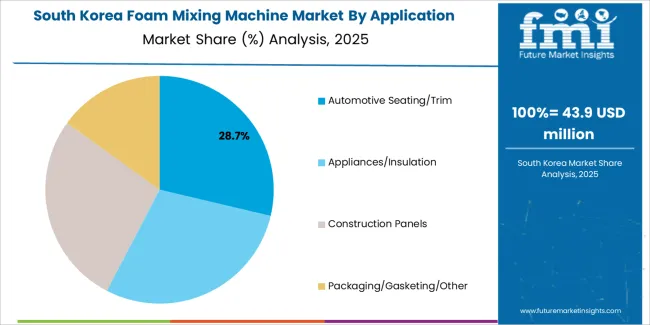
Revenue from foam mixing machines in South Korea is expanding at a CAGR of 3.5%, supported by the country's automotive supplier network, expanding appliance manufacturing sector, and strong emphasis on production automation and manufacturing efficiency. South Korea's advanced manufacturing infrastructure and technology adoption are driving demand for sophisticated mixing equipment. Leading automotive suppliers and appliance manufacturers are investing in automated mixing systems for component production.
Revenue from foam mixing machines in Japan is expanding at a CAGR of 2.8%, supported by the country's automotive manufacturing excellence, precision equipment capabilities, and strong emphasis on quality control and process consistency in foam processing applications. Japan's technological sophistication and manufacturing expertise are driving demand for high-precision mixing systems. Leading automotive manufacturers and equipment producers are investing in specialized mixing technologies for advanced foam applications.
Revenue from foam mixing machines in the United Kingdom is growing at a CAGR of 4%, driven by the country's automotive component manufacturing sector, appliance production capabilities, and growing emphasis on manufacturing automation and production efficiency improvements. The United Kingdom's industrial modernization programs and automotive supply chain are supporting investment in advanced mixing technologies. Automotive suppliers and equipment users are establishing comprehensive automation initiatives incorporating advanced mixing systems.
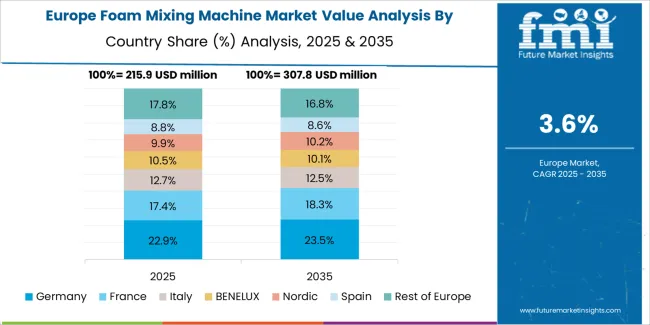
The foam mixing machine market in Europe is projected to grow from USD 290 million in 2025 to USD 440 million by 2035, registering a CAGR of 4.2% over the forecast period. Germany is expected to maintain leadership with a 28.5% market share in 2025, moderating to 28.2% by 2035, supported by automotive supplier strength, precision machinery manufacturing, and advanced automation adoption.
France follows with 19.2% in 2025, projected at 19.5% by 2035, driven by automotive component production, appliance manufacturing, and construction material innovation. The United Kingdom holds 16.8% in 2025, maintaining 16.8% by 2035, supported by automotive manufacturing and industrial modernization programs. Italy commands 14.5% in 2025, rising slightly to 14.6% by 2035, while Spain accounts for 10.2% in 2025, reaching 10.4% by 2035 aided by automotive production and furniture manufacturing. Poland maintains 5.8% in 2025, up to 6% by 2035 due to expanding automotive supplier networks and manufacturing capacity additions. The Rest of Europe region, including Nordic countries, Central & Eastern Europe, and other markets, is anticipated to hold 5% in 2025 and 4.5% by 2035, reflecting established manufacturing positions in specialized foam applications and niche automotive components.
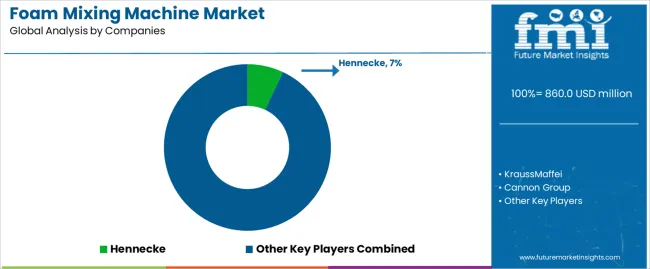
The foam mixing machine market is characterized by competition among established machinery manufacturers, specialized foam equipment producers, and diversified industrial equipment companies. Companies are investing in automation technology development, digital integration innovation, product portfolio expansion, and application-specific system development to deliver high-performance, reliable, and cost-effective foam mixing solutions. Innovation in smart manufacturing capabilities, precision metering technologies, and energy-efficient mixing systems is central to strengthening market position and competitive advantage.
Hennecke leads the market with a 7% share, offering comprehensive foam mixing solutions with a focus on polyurethane processing applications, automated production systems, and advanced metering technologies across diverse automotive and industrial applications. KraussMaffei provides innovative mixing equipment with emphasis on high-volume production capabilities and process integration. Cannon Group delivers specialized foam processing systems with focus on flexible manufacturing solutions. Graco offers advanced metering and mixing equipment with emphasis on precision dispensing applications. SAIP Equipment provides foam mixing solutions for automotive and industrial sectors. Polytec EMC specializes in mixing systems for polyurethane applications.
BASF Polyurethane Systems delivers integrated machinery solutions supporting foam production operations. Linden Industries focuses on specialized mixing equipment for industrial applications. Höfer Presstechnik offers foam processing systems with emphasis on automotive components. Larius provides mixing equipment for diverse foam manufacturing applications.
Foam mixing machines represent a specialized industrial equipment segment within manufacturing and processing applications, projected to grow from USD 860 million in 2025 to USD 1,310 million by 2035 at a 4.3% CAGR. These automated mixing systems—primarily high-pressure and low-pressure configurations for multiple foam chemistries—serve as critical production equipment in automotive component manufacturing, appliance production, construction panel fabrication, and packaging operations where enhanced precision, consistency, and production efficiency are essential. Market expansion is driven by increasing automotive production volumes, growing construction insulation requirements, expanding appliance manufacturing capacity, and rising demand for automated processing solutions across diverse industrial manufacturing segments.
How Industrial Regulators Could Strengthen Equipment Standards and Safety Performance?
How Industry Associations Could Advance Technology Standards and Market Development?
How Foam Mixing Machine Manufacturers Could Drive Innovation and Market Leadership?
How End-User Industries Could Optimize Equipment Performance and Production Efficiency?
How Research Institutions Could Enable Technology Advancement?
How Investors and Financial Enablers Could Support Market Growth and Innovation?
| Items | Values |
|---|---|
| Quantitative Units (2025) | USD 860 million |
| Foam Chemistry | PU-Flexible, PU-Rigid, Silicone/Epoxy, Phenolic & Others |
| Metering/Mix Type | High-Pressure Meter Mix, Low-Pressure Mix, Static Mixers, Vacuum-Assisted |
| Application | Automotive Seating/Trim, Appliances/Insulation, Construction Panels, Packaging/Gasketing/Other |
| Automation Level | Batch/Manual Assist, Semi-Automatic, Fully Automatic |
| Key Countries Covered | United States, Germany, China, Japan, South Korea, United Kingdom, Brazil, and 40+ countries |
| Key Companies Profiled | Hennecke, KraussMaffei, Cannon Group, Graco, SAIP Equipment, Polytec EMC |
| Additional Attributes | Dollar sales by foam chemistry, metering/mix type, application category, and automation level; regional demand trends; competitive landscape; technological advancements in mixing systems; automation development; digital integration innovation; and process efficiency optimization |
The global foam mixing machine market is estimated to be valued at USD 860.0 million in 2025.
The market size for the foam mixing machine market is projected to reach USD 1,310.2 million by 2035.
The foam mixing machine market is expected to grow at a 4.3% CAGR between 2025 and 2035.
The key product types in foam mixing machine market are high-pressure meter mix, low-pressure mix, static mixers and vacuum-assisted.
In terms of application, automotive seating/trim segment to command 28.0% share in the foam mixing machine market in 2025.






Full Research Suite comprises of:
Market outlook & trends analysis
Interviews & case studies
Strategic recommendations
Vendor profiles & capabilities analysis
5-year forecasts
8 regions and 60+ country-level data splits
Market segment data splits
12 months of continuous data updates
DELIVERED AS:
PDF EXCEL ONLINE
Foam Market Size and Share Forecast Outlook 2025 to 2035
Foam-Free Pad Formers Market Size and Share Forecast Outlook 2025 to 2035
Foam Cups Market Size and Share Forecast Outlook 2025 to 2035
Foam Bottle Technology Market Size and Share Forecast Outlook 2025 to 2035
Foaming Agents Market Size and Share Forecast Outlook 2025 to 2035
Foam Glass Granulate Market Size and Share Forecast Outlook 2025 to 2035
Foam Plastics Market Size and Share Forecast Outlook 2025 to 2035
Foaming Creamer Market Size and Share Forecast Outlook 2025 to 2035
Foam Tape Market Size and Share Forecast Outlook 2025 to 2035
Foam Glass Market Size and Share Forecast Outlook 2025 to 2035
Foamer Pump Market Size, Share & Forecast 2025 to 2035
Foam Food Container Market Size and Share Forecast Outlook 2025 to 2035
Foam Mesh Sleeves Market Growth - Demand & Forecast 2025 to 2035
Foam Edge Protectors Market Size and Share Forecast Outlook 2025 to 2035
Foamer Bottle Market Size and Share Forecast Outlook 2025 to 2035
Foam Cap Liners Market Size and Share Forecast Outlook 2025 to 2035
Foam Pouch Market Analysis - Demand, Size & Industry Outlook 2025 to 2035
Foam Cooler Box Market Analysis - Growth & Trends 2025 to 2035
Foam Packaging Inserts Market Analysis, Size, Share & Forecast 2025 to 2035
Foam Labels Market Trends and Growth 2035

Thank you!
You will receive an email from our Business Development Manager. Please be sure to check your SPAM/JUNK folder too.
Chat With
MaRIA